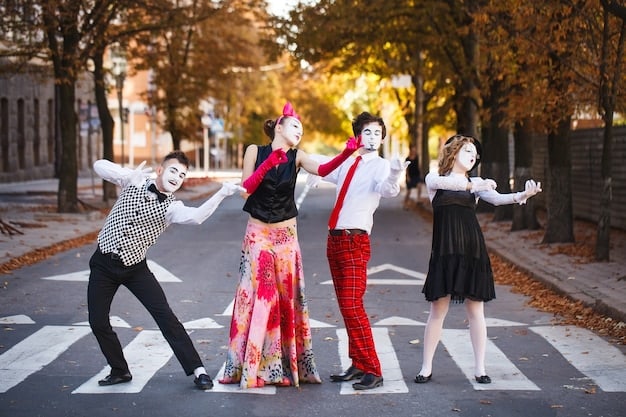Beyond the Hype: Analyzing Staying Power of Viral Challenges

Beyond the Hype: Analyzing the Staying Power of 3 Recent Viral Challenges explores why some viral trends fade quickly while others endure, examining the cultural, technological, and psychological factors that contribute to their longevity.
The internet is a breeding ground for viral trends, with new challenges and fads emerging daily. While some capture our attention for a fleeting moment, others manage to stick around, becoming ingrained in internet culture. Beyond the Hype: Analyzing the Staying Power of 3 Recent Viral Challenges can reveal the secrets to sustainable virality.
Understanding Viral Trends: A Fleeting Moment or Lasting Impact?
Viral trends sweep across the internet at an alarming rate, but what determines whether they become a cultural phenomenon or a short-lived fad? The answer lies in a complex interplay of factors ranging from their emotional resonance to their ease of replication.
Let’s start with the basics. Viral trends, by definition, are phenomena spread rapidly through online platforms. They gain momentum through shares, likes, and participation, but their lasting impact varies significantly. Do they need to have an impact? Not always, but this impact is usually the key for longevity.
The Initial Spark: What Makes a Challenge Go Viral?
Before analyzing staying power, it’s crucial to understand what ignites the initial spark. Several elements contribute to a challenge’s initial virality.
- Simplicity: Challenges that can be easily understood and replicated are more likely to gain traction.
- Emotional Connection: Trends that evoke strong emotions, like humor, empathy, or nostalgia, have a higher chance of going viral.
- Social Proof: Seeing others participate encourages individuals to join in, creating a snowball effect.
However, initial virality doesn’t guarantee long-term success. Many trends burn brightly but quickly fade into obscurity.

Assessing a trend’s potential involves gauging these factors, but the real test lies in how well it adapts and evolves.
Case Study 1: The Ice Bucket Challenge – A Lasting Impact on Awareness
The Ice Bucket Challenge, which involved people dumping buckets of ice water on their heads to raise awareness for amyotrophic lateral sclerosis (ALS), swept the world in the summer of 2014. It’s important to understand why this trend stuck around.
This challenge wasn’t just about the shock value; it tapped into a genuine desire to support a worthy cause. Celebrities also played a big part on promotion of the trend.
Positive Factors Leading to Longevity
The Ice Bucket Challenge possessed several factors that contributed to its sustained impact.
- Clear Cause: The challenge was directly linked to raising awareness and funds for ALS research.
- Celebrity Involvement: High-profile figures like Bill Gates and Oprah Winfrey participated, amplifying its reach.
- Network Effect: Participants challenged others to take part, creating a chain reaction of involvement.
It transformed how people perceived online activism, demonstrating the potential of viral trends to drive social change.
Even now, years later, Ice Bucket challenges can surface, reminding people of the cause. This might be a great factor that makes a trend stick around.
Case Study 2: The Harlem Shake – A Momentary Dance Craze
The Harlem Shake, defined by its abrupt shift from calm to chaotic dancing, dominated social media in early 2013. Though intensely viral for a brief period, its staying power proved limited. Let’s find out why.
The main benefit of the trend was its pure entertainment value and short length. This made it easily consumable and shareable.
Understanding the Short-Lived Nature
Several factors contributed to the Harlem Shake’s rapid rise and fall.
- Lack of Deeper Meaning: The challenge had no underlying message or purpose, making it purely entertainment-driven.
- Oversaturation: The sheer number of Harlem Shake videos led to fatigue and a decline in interest.
- Limited Adaptability: The format remained largely unchanged, preventing evolution and innovation.
Unlike the Ice Bucket Challenge, which had a clear cause and charitable component, the Harlem Shake was ephemeral.

Its absence of a deeper purpose made it difficult to sustain long-term interest.
Case Study 3: The Mannequin Challenge – Frozen in Time?
The Mannequin Challenge, where participants freeze in place like mannequins while being filmed, gained traction in late 2016. It was simple enough to be replicated, but what about its lasting power?
The Mannequin Challenge differentiated itself from most trends with its visual appeal and collaborative element.
Factors Contributing to Moderate Staying Power
The Mannequin Challenge possessed characteristics that helped it maintain a moderate level of popularity.
- Visual Appeal: The challenge created visually arresting scenes, especially when executed creatively.
- Collaborative Nature: It often involved groups of people, fostering a sense of community and shared experience.
- Adaptability: The challenge could be adapted to various themes and settings, offering some room for creativity.
However, the Mannequin Challenge lacked the social impact and emotional connection of the Ice Bucket Challenge.
Although it remains an occasional reference point, it couldn’t achieve the staying power of the Ice Bucket Challenge.
The Psychology Behind Viral Trends: Why We Participate
To truly understand the staying power of viral trends, it’s important to delve into the psychological factors that drive our participation.
Humans are social creatures, so many trends rely upon social recognition and acceptance. But what are some other factors?
Key Psychological Drivers
Several psychological factors influence our engagement with viral trends.
- Social Identity: Participating in trends allows us to express our identities and connect with like-minded individuals.
- Fear of Missing Out (FOMO): The desire to avoid being left out motivates us to join in on popular trends.
- Sense of Belonging: Viral trends can create a sense of community, especially when they involve shared goals or experiences.
These psychological drivers are crucial to consider when evaluating a trend’s potential longevity.
A trend that addresses our innate social needs tends to resonate more deeply and last longer.
Predicting the Longevity of Viral Trends
While predicting the future of any trend is challenging, certain indicators can help assess its potential staying power.
Combining initial assessment with the consideration of deeper values is a great step forward.
Key Indicators of Staying Power
Consider these indicators when evaluating the longevity of viral trends.
- Underlying Purpose: Trends with a clear purpose or message are more likely to endure.
- Adaptability: Trends that can be adapted and remixed over time have a higher chance of staying relevant.
- Community Building: Trends that foster a sense of community and shared identity tend to have longer lifespans.
By understanding these indicators, we can better evaluate which trends have the potential to stick around.
The key is to look beyond the initial hype and focus on deeper factors that resonate with human values and social needs.
| Key Point | Brief Description |
|---|---|
| 💡 Initial Virality | Driven by simplicity, emotional connection, and social proof. |
| 💖 Emotional Resonance | Connects to a clear cause, desire, value, or community. |
| 🔄 Adaptability | Evolves and is remixed over time, remaining innovative. |
| 🤝 Community Building | Creates a sense of belonging and shared identity. |
FAQ
▼
A successful viral challenge combines simplicity, emotional connection, and social proof. It’s easy to understand and replicate, evokes emotions, and receives social validation.
▼
Some trends fade due to a lack of deeper meaning, oversaturation, and the inability to adapt. They lack a lasting impact, emotional connection, or an underlying purpose to keep users engaged.
▼
Social media platforms act as a catalyst by providing channels for rapid dissemination and social interaction. They amplify reach and provide opportunities for trends to evolve dynamically with user feedback.
▼
Celebrities significantly amplify viral trends by reaching mass audiences and legitimizing participation. Their involvement builds awareness and credibility, driving broader adoption across social networks.
▼
Yes, businesses can effectively leverage viral trends for marketing. By aligning their brand with trending themes and values, they can drive brand exposure, engage with customers, and increase site traffic creatively.
Conclusion
In conclusion, while the nature of virality is often unpredictable, it’s clear that certain qualities contribute to the staying power of viral trends. By understanding the factors that drive our participation, we can better assess which trends have the potential to make a lasting impact on the internet and beyond.





